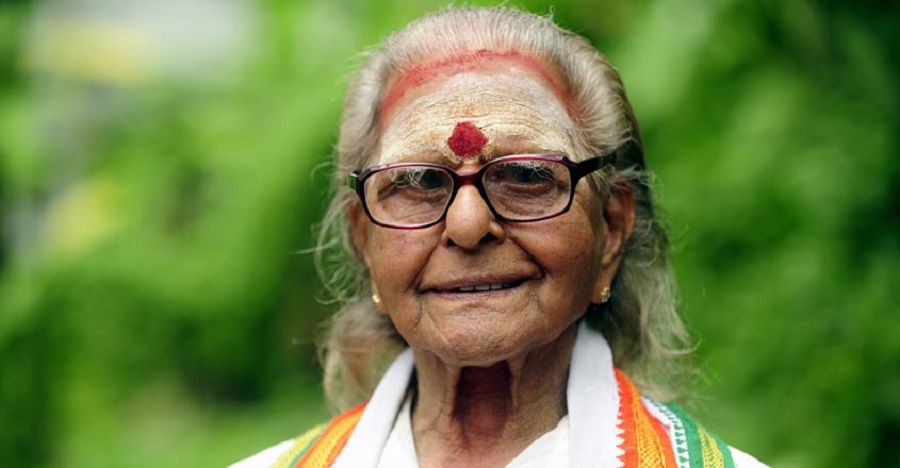With his remarkable journey for more than 90 years, Guru Chemancheri Kunhiraman Nair was an exemplar in Kathakali
The Ides of March is generally believed to be inauspicious and that of 2021 was more. When the electronic media broke the news of the demise of Kathakali Acharya Guru Chemancheri Kunhiraman Nair at the age of 105 at his residence in Cheliya near Koyilandy during the wee hours on March 15, a pall of gloom descended on the Kathakali world. Frenetic phone calls continued for hours for ascertaining the veracity of the news. He was leading a secluded life in his home after the onset of the pandemic last year.
The ever-smiling face with the innocence of a child and the warmth of his company will remain etched in the memory of those who have ever met him. For the same reason, one always felt that he was 105 years young. “He maintained the same lightness in his spring, the same buoyancy in his movements and the same fluidity in his lines as in the thirties”, to quote K Bharatha Iyer’s description of an old and seasoned Kathakali artiste. Incidentally, Bharatha Iyer’s book ‘Kathakali’, was the first book in English that served as an introduction of the dance-theatre to the Westerners. Going by the description in the book, a Kathakali fan had once wondered whether the author had in his mind the image of Kunhiraman Nair while scripting it.
Unparalleled artist
Kunhiraman Nair exhibited an unmatched zeal for abhinaya right from early childhood. He proved this by donning the role of a maidservant in a drama that won him acclaim. His quest for histrionic arts made him leave his home at the age of 15. He joined the Radhakrishna Kathakali yogam run by Appukutty Nambiar in Meppayur in Malabar. Later, he honed his artistry under the maestro Guru Karunakara Menon. The guru-sishya combine turned into a popular duo in Malabar those days. Innumerable were the stages on which the guru portrayed Kuchela while the disciple, Krishna. Sadly enough it was on one such occasion that Menon breathed his last lying in the lap of his disciple.
For the Kathakali fans, he was ‘Kunjan Krishnan’, a title obtained for his portrayal of Krishna in plays like ‘Duryodhanavadham’,’Kuchelavritham’, ‘Rukmini Swayamvaram etc. The late Justice V R Krishna Iyer in his message during the navathi celebrations of Kunhiraman Nair in 2006, had described how a Munsiff had prostrated before the artiste’s Krishna, taking him for the real Bhagavan. The doyen also proved a versatile performer by enacting Panchali in ‘Kiratam’, Sthree in ‘Santhanagopalam, Parasurama in ‘Lavanasura vadham’ and Hanuman in ‘Sitaswayamvaram’. Perhaps his last public performance was in connection with his centenary celebrations at Kozhikode when he donned the role of Parasurama.
A teacher par excellence
However, northern Malabar was not a fertile ground for Kathakali in those days. This compelled him to take to classical dance. Groomed by stalwarts like Guru Rajaratnam Pillai who was a direct disciple of Panthanellur Meenakshi Sundaram Pillai and Kalamandalam Madhavan he became an accomplished Bharatanatyam dancer. He associated himself with Guru Gopinath to get , Kerala Natanam approved by the government. In 1944, he founded the first Malabar dance school, ‘Bhartanatya Nrita Vidyalaya’ in Kannur and later its branch in Thalassery. Hundreds of dancers trained by him enabled him to form a ballet troupe. More than 40 ballets choreographed by him marked the revival of this art form in Malabar. He also founded the famous cultural institution ‘Pookad Kalalayam’ in 1979.
In 1983, Kathakali Vidyalaya of Chemancheri was inaugurated by the then governor of Kerala P Ramachandran. It was a realisation of his dream. The institution today has grown into one of the most renowned institutions in the country imparting Kathakali and its allied departments to students in Malabar. Workshops and lectures by eminent artists are regularly held here in which participants turn up from all parts of Kerala.
He was the winner of the Padma Shri award in 2017 and was also the recipient of several other honours including the Kerala Sangeetha Nataka Akademi Award in 1979, Kerala Kalamandalam award in 2001, Kalaratnam award in 2009, Mayilpeeli award and Sangeet Natak Akademi Tagore Award for his contributions to Kathakali.

